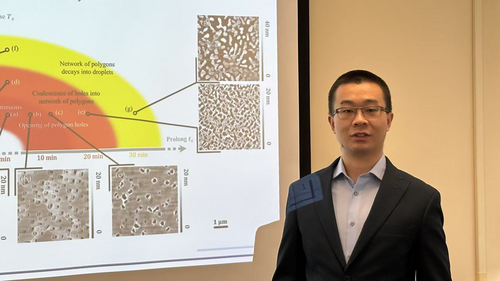
On April 14, Shuhang Pan successfully defended the thesis “Fabrication and Characterization of Chalcogenide and Oxide Thin Films” (advisor: Charles Ahn).
Pan explained, “Quantum materials—substances with exotic electronic behaviors governed by quantum mechanics—hold promise for revolutionizing technologies like ultra-efficient electronics and quantum computing. My research focuses on controlling these materials’ properties by sculpting their atomic structures and nanoscale geometries. Using advanced synthesis techniques, I crafted ultrathin films and patterned nanostructures from compounds like topological materials tin telluride (SnTe) and superconducting nickelates. By studying how electrons flow in these materials, I uncovered how their quantum states persist even in complex geometries, while also revealing how tiny defects or interfaces can make or break their performance. For instance, creating films with nanoscale holes enhanced surface-based quantum effects, and engineering interfaces in superconductors boosted their efficiency. This work bridges atomic-scale design with real-world applications, offering tools to tailor quantum materials for future devices—from energy-efficient electronics to robust quantum circuits. Ultimately, it’s about unlocking nature’s quantum rules to build technologies we’ve only imagined.”
Pan’s future plans are undecided.
Thesis Abstract: This dissertation explores the fabrication, structural characterization, and quantum transport properties of chalcogenide and oxide thin films. High-quality SnTe films were synthesized via molecular beam epitaxy (MBE), demonstrating tunable topological surface states through nanoscale patterning. Magnetoconductivity measurements revealed weak antilocalization (WAL) effects across continuous and patterned films, with coherence lengths governed by boundary scattering in hole-patterned geometries. Advanced focused ion beam (FIB) protocols enabled atomic-resolution transmission electron microscopy (TEM) of monolayer ZrO2 on silicon, defect distribution in off-stoichiometric CaWO4 films and phase analysis in YVO4 thin films. Josephson junctions fabricated on superconducting Nd1-xEuxNiO2 thin films exhibited macroscopic quantum transport behavior. By integrating nanofabrication with multi-scale characterization, this work establishes design principles for investigating quantum phenomena in low-dimensional systems, advancing applications in topological electronics and superconducting devices.